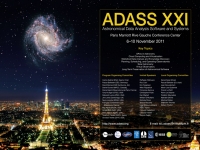Quasi-real-time adaptive optics simulations on GPUs for the next generation extremely large telescopes
Damien Gratadour (LESIA - Observatoire de Paris )
Abstract
Final design studies for the first generation of Adaptive Optics (AO) systems for the E-ELT (European Extremely Large Telescope) should begin in 2012, the first step of which will involve realistic end-to-end numerical simulations of the instruments and their environment. Because of the extremely large size of this next generation telescope, the number of degrees of freedom to simulate involves the manipulation of large arrays (10-50k x 10-50k) and thus requires a parallel implementation to achieve reasonable execution times. Main operations on these arrays include Fast Fourier Transform, matrix-vector multiplication, matrix inversion and singular value decomposition. Our team has started the development of a simulation code dedicated to GPUs able to target the E-ELT size. It uses the CUDA toolkit and an original binding to Yorick (an open source interpreted language) to provide the user with a comprehensive interface.
In this paper we present the first performance analysis of our simulation code, showing its ability to provide Shack-Hartmann (SH) images and measurements at the kHz scale for VLT-sized AO system and in quasi-real-time (up to 70 Hz) for ELT-sized on a single top-end GPU. The simulation code includes multiple layers atmospheric turbulence generation, ray tracing through these layers, image formation at the focal plane of every sub-aperture of a SH sensor using either natural or laser guide stars and centroiding on these images using various algorithms. Turbulence is generated on-the-fly giving the ability to simulate hours of observations without the need of loading extremely large phase screens in the global memory. Because of its performance this code additionally provides the unique ability to test real-time controllers for future AO systems under nominal conditions.
This open source project is distributed under a GPL license and can be used to simulate a wide range of AO systems from classical AO on a medium size telescope to multi-conjugate AO on an ELT. Simulation parameters (number of turbulent layers, turbulence strength, number and position of targets, etc �) can be modified dynamically thanks to the modular underlying implementation using the Standard Template Library. While a simulation run is fully scriptable, a Graphical User Interface is also provided for easier fine tuning of the system parameters and easier access to sophisticated system designs.
Slides in PDF format
Paper ID: O16

